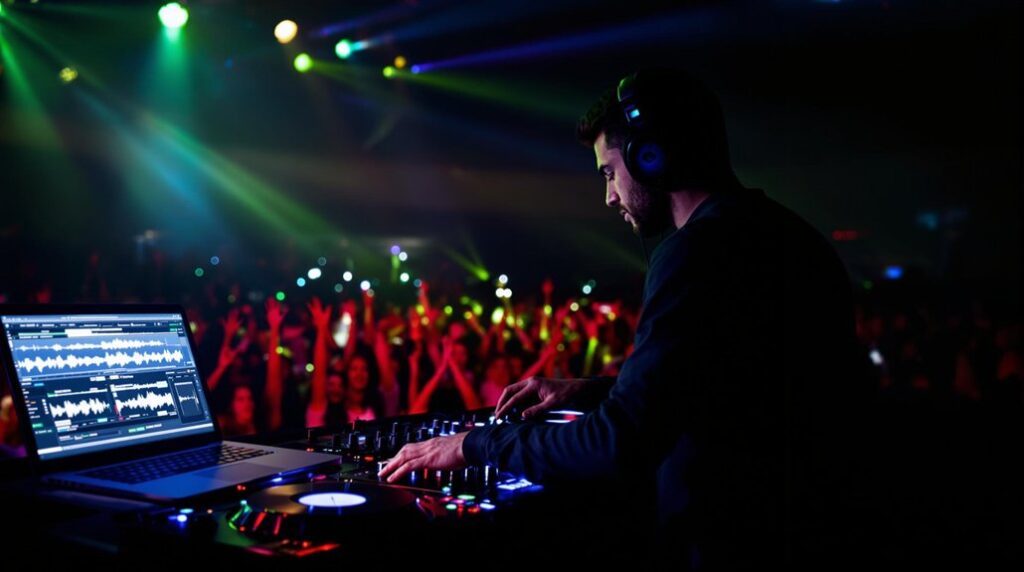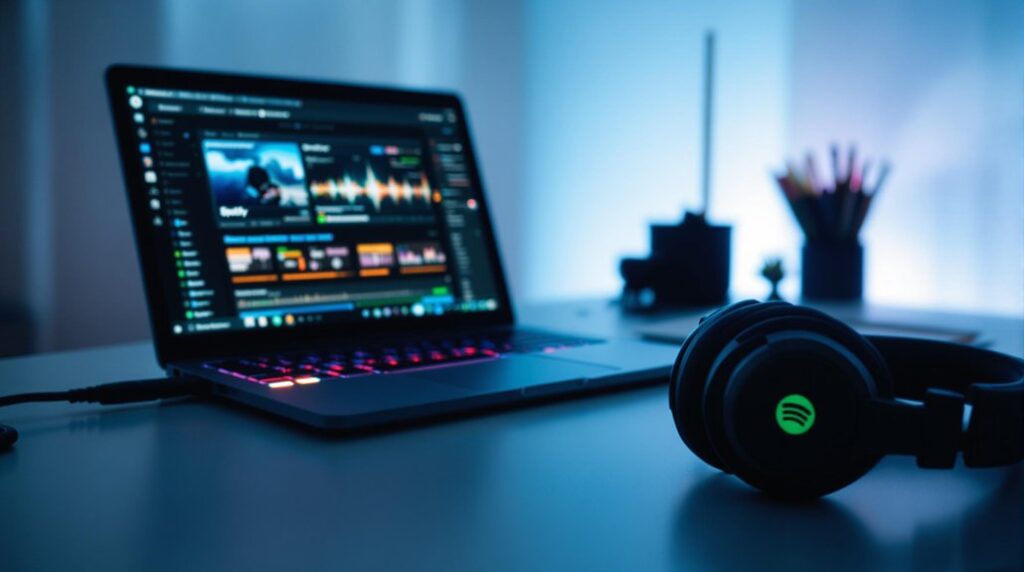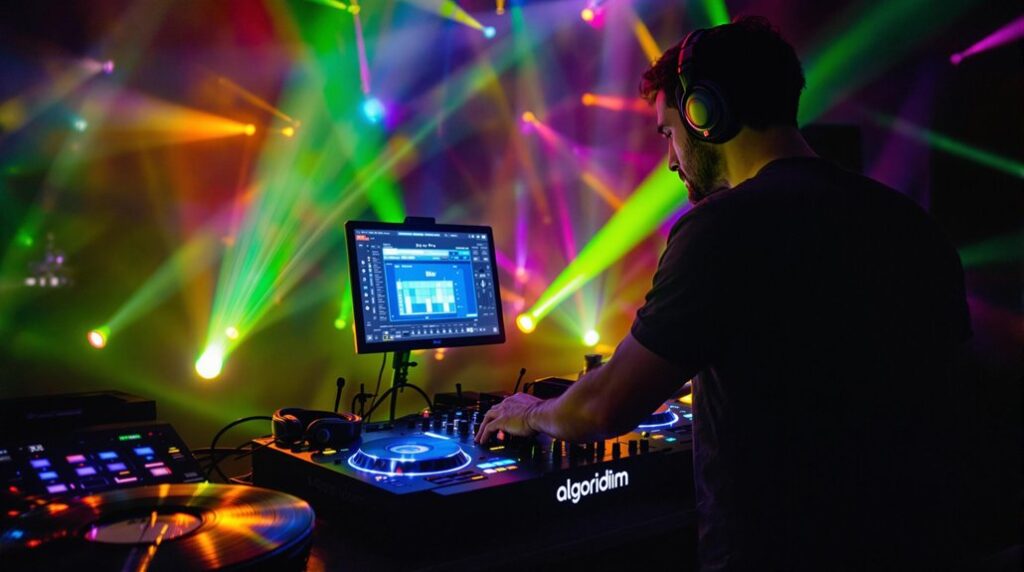Incorporating synthesizers into DJ sets requires a multifaceted approach involving MIDI interfaces for synchronization, audio interfaces for quality sound routing, and robust DJ software to integrate synth inputs. Techniques such as sound layering and MIDI synchronization are essential for blending synth textures with DJ tracks. Leveraging advanced tools like DAWs allows for chopping samples into BPM-specific loops and guarantees cohesive manipulation of live performances. Employing strategic compartmentalization between sample-based tracks and live synth improvisation keeps audiences engaged. Exploring more about these integration techniques and tools will greatly enhance your DJ sets, making them more immersive and dynamic.
Key Takeaways
- Use a MIDI interface to synchronize your synthesizers with DJ software, ensuring precise timing alignment.
- Integrate a compact synth module like Korg Volca for limited space setups while maintaining sound versatility.
- Employ sound layering techniques to blend synth textures with DJ tracks, enhancing overall audio dynamics.
- Utilize DJ software features for real-time audio mixing and effects application on synthesizer inputs.
- Engage in continuous learning through online tutorials and community forums to master synthesizer integration in DJ performances.
Tools and Setup
Incorporating synthesizers into your DJ setup requires several essential pieces of equipment to guarantee seamless integration and ideal performance. At the forefront, a MIDI interface is indispensable for achieving precise synchronization between your synthesizer and DJ software. This device guarantees that MIDI clocking is accurate, preventing any tempo drift, which is fundamental for maintaining a cohesive audio experience.
An equally significant component is a high-quality audio interface. This hardware enhances the sound quality of both your DJ tracks and synthesizer outputs. It facilitates efficient audio routing, allowing you to direct audio signals from various sources into your mixer with minimal latency.
To further improve your setup, consider using software like Virtual DJ, which offers extensive effects libraries and real-time audio mixing capabilities that can complement your synthesizer inputs beautifully. A DJ mixer equipped with advanced effects and filters can greatly enhance your performance, providing greater control over the blending of synth and DJ tracks.
Proper planning of audio routing is paramount; verify all signals are appropriately channeled to prevent any audio conflicts during live sets.
When selecting synth modules, consider the spatial and performance requirements of your setup. Compact units like the Korg Volca series are ideal for limited space, while Eurorack systems offer expansive flexibility for more elaborate configurations.
This tailored selection will optimize your performance capabilities and verify your setup aligns with your artistic vision.
Integration Techniques
Effectively integrating synthesizers into your DJ sets necessitates an understanding of both hardware and software synchronization techniques. Central to this is the use of MIDI synchronization, which guarantees that your synths and DJ tracks maintain precise timing alignment.
Start by incorporating a MIDI interface in your setup and enabling sync in your DJ software preferences. This allows for seamless time alignment, reducing the risk of timing discrepancies during live performances. For those utilizing advanced DJ software like Djay Pro AI, taking advantage of features such as Customizable Shifts can further enhance your ability to integrate synths smoothly.
When preparing for a set, utilize your DAW to chop samples into BPM-specific loops. This facilitates easy triggering and maintains a cohesive sound.
Sound layering techniques are vital here, as they enable the blending of synth textures with your DJ tracks. Adjusting synth envelopes and employing ambient interludes can create dynamic shifts, enriching the auditory experience.
Furthermore, maintaining balanced audio routing is key to prevent phase issues and guarantee consistent sound quality. Regularly evaluate the levels between your synths and DJ tracks, adjusting as necessary to avoid fluctuations.
This meticulous approach to integration allows for a polished and professional performance, enhancing your overall set with the additional depth and texture that synthesizers provide.
Performance Dynamics
A well-executed performance dynamic often hinges on the strategic compartmentalization of your set, allowing for a focused delineation between sample-based tracks and live synth improvisations. This segmentation not only maintains audience engagement but also provides a structured framework for the DJ to showcase diverse skills.
Adjusting synth envelopes can create dynamic sound introductions, enhancing shifts and keeping the performance fresh. Additionally, integrating harmonic mixing can boost the overall audio experience, ensuring that transitions between tracks and synth improvisations are musically compatible.
Incorporating DJ tools such as vocal loops and ambient interludes adds layers of complexity, offering creative opportunities for unique shifts. These elements can be seamlessly integrated into your synth setup, providing sonic bridges that captivate the audience.
Utilizing tools like the Octatrack’s live resampling capabilities allows for the introduction of new sound elements, adding depth and variety to your set.
A flexible set structure is essential for performance dynamics, encouraging experimentation and allowing for mental breaks. This flexibility enables varied interactions, which can be pivotal in maintaining the audience’s attention.
Benefits and Considerations
Integrating synthesizers into DJ sets offers considerable benefits, enhancing the creative latitude available to performers. By layering unique sounds and textures over pre-existing tracks, DJs can explore sound exploration, fostering a dynamic live performance. This practice not only enriches the auditory experience but also allows for a higher level of creative expression, enabling DJs to craft a signature sound. Incorporating unexpected track shifts can also captivate and surprise the audience, maintaining their interest throughout the performance.
Utilizing hardware synths comes with the added advantage of offloading tasks from computer resources, thereby ensuring performance stability. In addition, the tactile feedback provided by hardware synths can greatly engage both the performer and the audience, enhancing the interactive aspect of the show. Synths also facilitate real-time sound manipulation, allowing DJs to improvise and generate custom sounds on-the-fly. This capability adds a personalized touch to the set, distinguishing it from traditional tracks.
Incorporating synth elements can boost audience engagement through the creation of immersive soundscapes, promoting spontaneous interactions during the performance. Moreover, synthesizers provide innovative opportunities for shifts between tracks, maintaining audience interest and enriching the overall sound experience.
These benefits underscore the importance of synthesizers in modern DJ setups, where sound exploration and creative expression are paramount.
Learning Resources
Understanding the profound benefits of synthesizers in DJ sets naturally leads to the need for thorough learning resources to master their integration. To excel in incorporating synths into DJ performances, one must leverage various educational avenues, ranging from digital platforms to community interactions.
It’s also essential to understand MIDI Mapping to enhance dynamic interaction with your synth setup, allowing for real-time sound manipulation.
1. Online Tutorials and Workshops: Numerous platforms offer detailed online tutorials and workshops that provide step-by-step guidance tailored for both beginners and advanced users. These resources cover a wide array of topics, including MIDI mapping, sound design, and real-time synth manipulation.
2. Community Forums and Social Media Groups: Engaging with community forums and social media groups dedicated to synth and DJ enthusiasts can be incredibly beneficial. These platforms allow DJs to share experiences, exchange tips, and discuss techniques.
Participation in these communities fosters a collaborative learning environment and provides real-time feedback from peers.
3. Thorough Articles and Gear Demos: Access to over 28,000 articles and detailed gear demos offers invaluable insights into various synthesizers and their applications in DJing. These resources explore technical terminologies, production techniques, and practical applications, enabling a deeper understanding of how to seamlessly integrate synths into live sets.
Moreover, consulting with industry experts or attending local workshops can provide personalized recommendations and hands-on experience, further enhancing the learning journey.
Frequently Asked Questions
Can You DJ With a Synthesizer?
Yes, DJs can effectively integrate synthesizers into their setups using MIDI sync for precise timing. Employing advanced synth techniques during live performance enhances creativity, allowing real-time sound manipulation and dynamic layering to enhance the overall auditory experience.
How Do You Connect Multiple Synths to a Mixer?
To connect multiple synths to a mixer, utilize synth routing techniques with 1/4″ TRS or TS cables for line outputs. Employ audio interfaces for MIDI synchronization, and consider a patch bay for flexible connections. Adjust mixer gain levels accordingly.
How Do You Connect DJ Instruments?
To connect DJ instruments, establish proper synth signal flow by routing audio through high-quality interfaces and mixers. Guarantee MIDI connectivity by configuring your DJ software to synchronize MIDI clock signals, facilitating seamless integration and accurate timing during performances.
Do You Need a Mixer for Synths?
Yes, a mixer is essential for a synth setup. Mixer features such as multiple channels, real-time effects, and MIDI capabilities facilitate seamless integration, synchronization, and sound shaping, thereby enhancing the complexity and coherence of live DJ performances.
Conclusion
Incorporating synthesizers into DJ sets enhances sonic diversity and boosts performance dynamics. The integration of hardware and software tools necessitates a nuanced understanding of MIDI mapping, signal routing, and real-time modulation. Mastery of these techniques allows for seamless shifts and innovative soundscapes. While the inclusion of synths presents challenges, such as increased setup complexity and potential technical issues, the benefits regarding creative expression and audience engagement are substantial. Continuous learning and adaptation are essential for peak implementation.




